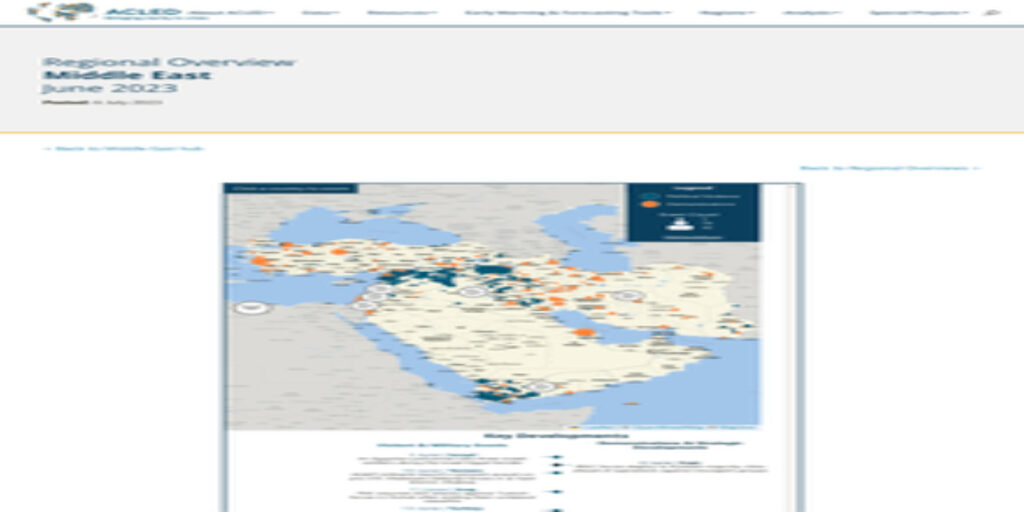Iran: Crackdown on Kurdish militants in northwestern Iran
The Islamic Revolutionary Guard Corps (IRGC) conducted armed operations throughout June against the Kurdistan Free Life Party (PJAK) and other Kurdish armed groups in Kurdish-majority districts bordering Turkey and Iraq. IRGC forces shelled Kurdish positions and engaged in armed clashes that left at least three Iranian soldiers dead. IRGC operations focused on the provinces of West Azerbaijan, Kurdistan, and Kermanshah where, overall, political violence increased ninefold in June compared to the month prior. This most recent activity comes after Iranian state forces targeted Iranian Kurdish groups in Iraqi Kurdistan in 2022, accusing them of inciting unrest inside Iran (*for more see the *ACLED 2023 Conflict Watchlist Report). Amid the increasing violence, the IRGC appointed two new regional commanders on 26 June.1 Several Iranian Kurdish armed groups – including PJAK and others – have been engaged in armed struggle against the Iranian government for decades demanding cultural rights, autonomy, and in some cases, outright independence.
Iraq: PKK-Turkey fighting expands to Erbil and Sulaymanyya after Turkish presidential election
Following the re-election of President Recep Tayyip Erdogan on 28 May, Turkish forces have expanded the geographic scope of their operations against the Kurdistan Workers Party (PKK) in Iraq. Between February and May 2023, Turkish activity was predominantly concentrated in the northern Duhok province. However, in June, Turkish airstrike and artillery events surged in northern Erbil province by over 200% compared to the month prior, reaching the highest level recorded by ACLED since October 2021. Similarly, the Turkish National Intelligence Organization (MIT) broadened its operations by assassinating three PKK officials near Chamchamal city and a member of the PKK-linked Mesopotamian Workers Union in al-Sulaymaniyya. Previously, MIT operations were primarily focused in Sinjar, Ninewa province, and the rural mountains of Duhok province.
Meanwhile, on 13 June, the PKK ended a unilateral ceasefire that began in February, citing continued anti-PKK operations.2 The ceasefire served the official purpose of facilitating earthquake rescue efforts. It also aimed to support opposition parties in Turkish elections, anticipating that their victory could lead to renewed peace talks with the Turkish state.3 Following Erdogan’s re-election, PKK attacks surged in Erbil and Duhok provinces, including explosive attacks on Turkish forces – the first since late 2022. Turkey and the PKK are engaged in a long-standing conflict over ethnic rights in southeastern Turkey and across the border in Iraq and Syria.
Israel and Palestine: Heightened tensions in the West Bank following Israeli raid on the Jenin camp
Tensions in the West Bank continued to be at the heart of the Israeli-Palestinian conflict last month. ACLED records a 20% increase in political violence in the West Bank in June compared to the month prior. Three major incidents drove the escalation of violence. On 19 June, Israeli forces raided Jenin city to arrest wanted Palestinians, prompting deadly clashes with militants from Fatah, Hamas, and PIJ. The clashes resulted in the reported deaths of five militants and two civilians, and injuries to at least 90 Palestinians and eight Israeli soldiers. The raid ignited a cycle of violence and retaliations. On 20 June, Hamas militants attacked a gas station in the Eli settlement near Nablus, killing at least four Israelis before being shot and killed by armed settlers. In response to the attack, on 21 June, hundreds of settlers attacked the Palestinian village of Turmus Ayya while under the protection of the Israeli military. Settlers destroyed Palestinian property and exchanged fire with Palestinian gunmen, killing one Palestinian and injuring 13 others.
Lebanon: Rare outbreak of violence in lands disputed with Israel
Tensions flared on the border between Lebanon and the Israeli-occupied Golan heights, resulting in a fivefold increase of political disorder in the southern Hasbaya district in June compared to the monthly average of the year prior. On 7 June, a Lebanese farmer prevented an Israeli bulldozer from carrying out digging operations on his land at Kafr Shuba. The video of the incident went viral, triggering a wave of demonstrations against Israeli activities.4 On 9 and 11 June, rioters tried to break the border fence around Kafr Shuba and hurled stones towards Israeli forces who responded by firing tear gas. Lebanese forces and the United Nations Interim Force in Lebanon (UNIFIL) were deployed to contain the clashes.
According to pro-Israeli sources, demonstrations were allegedly orchestrated by Hizbullah, who also established two manned observation posts in the nearby Shibaa farms – an area claimed by Lebanon, Israel, and Syria.5 Meanwhile, on 21 and 22 June, several demonstrators marched towards al-Majdiyya in solidarity with protests by members of the Druze community against Israel’s plans to build wind turbines on the Golan Heights.6 The situation on the Lebanese-Israeli borders remains fraught due to Israel’s continued occupation of the Kafr Shuba hills and Shibaa farms, which were seized during the 1967 Arab-Israeli war and are subject to competing claims by Lebanon.
Source : Relief Web


